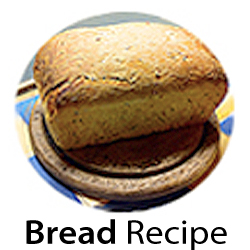
Ingredients:
Flour
150g wholemeal flour
250g white flour
Yeast (1 sachet)
Sugar 1 teaspoon
Olive Oil.
Water
Knob of butter (10g)
Bread tin if you want a sandwich loaf
Put a sachet of fresh yeast in a bowl with a teaspoon of sugar and pour on a little luke warm water. (up to about 100ml if you worried about quantities)
Yeast is a living thing that is activated by warm water and a little sugar. If the water is too hot it may kill the yeast. If it is too cold the yeast may not activate and rise properly. The water should be warm to the hand but not scalding.
Yeast must also be fresh and airtight for storage don’t use old yeast as it wont work.
Next mix the flour salt and a knob of butter together in a separate bowl and wait for the yeast to activate
Wait. . .
Waiting is part of the skill of making bread
When the yeast has got a nice frothy head on it and you can see it bubbling every so often its ready.
When this happens add the yeast to the mixed ingredients. if it doesn't produce a `frothy head' it is not fresh and won't raise the dough.
Making and kneading the bread dough
Mix the yeast mix into the bowl of mixed flour, butter and salt
gradually adding water that is poured in a little at a time until
the mix sticks together in a ball.
Pull the ball of dough out and put it on a floured or lightly oiled
flat surface and start working the dough.
There are many thoughts on the kneading process and again is part of
the skill of bread making.
But the best advice here is to have a go yourself for your first
bake.
You want to try to get the dough elastic and with some spring in it,
so for that you need to get that yeast kneaded well in.
If it sticks to your hand too much you can sprinkle some oil or
flour on it until the mix feels right.
When you think its elastic enough put the dough back in the mixing
bowl cover with an lightly oiled bag or cling film and wait. . . .
Waiting for the bread dough to rise.
If your making bread for the first time put the bread somewhere warm
(room temperature).
You want the dough to rise with its own pace - too warm and it may
rise very quickly and form a hard crust on the dough.
This is not the same as the crust on a cooked loaf and will need to
be re mixed before a second rise.
Too cold and the dough will not rise well
Just be patient with the rising process and it will rise well of its
own accord in its own time.
It usually takes between 3 and 5 hours for my dough to rise, but the
best practice for first time bread making is to check it at regular
intervals and see if its doubled in size.
Punch the dough and knead again
When it has risen punch the dough down with your fist and watch that
dough sink down.
Using a little oil or flour pull the dough back into a ball and
placing the dough back onto a work surface knead the dough over
again.
You can make it any shape you like here but this recipe is for a
loaf tin so I shape it into a rough rectangle.
However you can place it on a baking tray if you want to make a
basic artisan round loaf if you don’t have one.
Rub a small amount of fine flour over the top of the dough for a
great coloured top crust.
The loaf tin should be oiled to stop it sticking before the dough is
placed in it.
Waiting for the bread dough to rise for the second time:
Place the oiled bag over the top and allow the bread to rise again
in the loaf tin.
The reason for the oil on the bag is to stop it sticking if the
dough decides to rise quickly and touch the bag.
Some bread makers suggest that the bread should be left in a
slightly warmer place every time the dough is made to rise but
leaving the dough in the same temperature has not caused me any
problems.
It will take less time for the second rise where the dough will form
into the final loaf shape.
It’s ready when it looks like the size of loaf you want to bake and
eat.
Patience is called for here as its up to you to decide when its
ready.

Baking the bread:
Pre heat the oven to 225 and place a baking tray or Pyrex lid with
some water in it.
The water in the tray will create a little steam and this makes the
crust go that lovely brown colour.
When the oven has reached temperature, put the bread in the middle
of the oven and close the door quick to keep the heat in.
If you can keep the door closed for the entire 30 minute bake, but
if you need to check it you can turn it after 15 minutes to keep the
bake even.
When the bread has been baked, knock the bread out of the loaf tin
onto a wire rack to cool it.
You can gently tap the base of the bread at this stage and it should
sound a little hollow.
The Finished Bread Loaf
When it’s cooled it can be eaten fresh or frozen.
You should be able to cut the cooled loaf in half and check your
baking skills.
If the bread has an even crumb and tastes like great bread, then
congratulations. You’re a baker.
After trying out combinations and variants of this recipe including
mixing kneading, Proofing (also called proving), temperature and
baking times this method seems to be the most consistent and
easiest.

